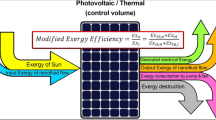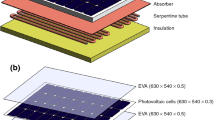Abstract
In this paper, the effects of using carbon-based nanofillers/water nanofluids as a coolant fluid in a photovoltaic thermal system from both energy and exergy viewpoints are experimentally presented. The considered nanoparticles including MWCNTs, SWCNTs, and GNPs are dispersed in deionized water as the base fluid by 0.05 mass%. The experiments are carried out on certain days in August and September at Ferdowsi University of Mashhad, Mashhad, Iran. In order to investigate the consistency of the results, an uncertainty of the experiments is examined. The various mass flow rates are investigated in all cases, and as a result, an optimum mass flow rate of 50 kg h−1 based on first and second laws of thermodynamics is selected. According to the results, employing GNP/water, SWCNT/water, and MWCNT/water increase the total average overall energy efficiency by 19.3%, 15.24%, and 9.46% in comparison with pure water, respectively. Additionally, GNP/water, SWCNT/water, and MWCNT/water reduce the total average entropy generation of the module by 2.88%, 1.23%, and 0.82% compared to the pure water, respectively. It has been found that implementation of GNP/water nanofluid leads to more improvement in the module performance among other coolant fluids.













Similar content being viewed by others
Abbreviations
- \(C_{\text{P}}\) :
-
Specific heat capacity (J kg−1 K−1)
- \(\dot{E}\) :
-
Power (W)
- \(\dot{E}x\) :
-
Exergy rate (W)
- F :
-
Arbitrary function
- FF:
-
Fill factor
- \(\dot{G}\) :
-
Solar irradiation rate (W m−2)
- \(I\) :
-
Electrical current (A)
- \(\dot{m}\) :
-
Mass flow rate (kg s−1)
- \(P\) :
-
Pressure (Pa)
- PVT:
-
Photovoltaic thermal
- \(T\) :
-
Temperature (K)
- \(V\) :
-
Velocity (m/s)
- α :
-
Absorptivity
- η :
-
Efficiency (%)
- σ :
-
Uncertainty
- \(\tau\) :
-
Transmissivity
- amb:
-
Ambient
- des:
-
Destruction
- elec:
-
Electrical
- g:
-
Glass cover
- in:
-
Inlet
- max:
-
Maximum
- oc:
-
Open circuit
- out:
-
Outlet
- pv:
-
PV
- sc:
-
Short circuit
- th:
-
Thermal
- wf:
-
Working fluid
References
Rashidi S, Karimi N, Mahian O, Abolfazli Esfahani J. A concise review on the role of nanoparticles upon the productivity of solar desalination systems. J Therm Anal Calorim. 2019;135(2):1145–59. https://doi.org/10.1007/s10973-018-7500-8.
Rashidi S, Bovand M, Rahbar N, Esfahani JA. Steps optimization and productivity enhancement in a nanofluid cascade solar still. Renew Energy. 2018;118:536–45. https://doi.org/10.1016/j.renene.2017.11.048.
Rashidi S, Kashefi MH, Hormozi F. Potential applications of inserts in solar thermal energy systems—a review to identify the gaps and frontier challenges. Sol Energy. 2018;171:929–52.
Sardarabadi M, Hosseinzadeh M, Kazemian A, Passandideh-Fard M. Experimental investigation of the effects of using metal-oxides/water nanofluids on a photovoltaic thermal system (PVT) from energy and exergy viewpoints. Energy. 2017;138:682–95. https://doi.org/10.1016/j.energy.2017.07.046.
Sardarabadi M, Passandideh-Fard M. Experimental and numerical study of metal-oxides/water nanofluids as coolant in photovoltaic thermal systems (PVT). Sol Energy Mater Sol Cells. 2016;157:533–42.
Chandrasekar M, Suresh S, Senthilkumar T. Passive cooling of standalone flat PV module with cotton wick structures. Energy Convers Manag. 2013;71:43–50.
Chow TT. A review on photovoltaic/thermal hybrid solar technology. Appl Energy. 2010;87(2):365–79.
Kalogirou SA, Tripanagnostopoulos Y. Hybrid PV/T solar systems for domestic hot water and electricity production. Energy Convers Manag. 2006;47(18–19):3368–82.
Chow TT, Pei G, Fong K, Lin Z, Chan A, Ji J. Energy and exergy analysis of photovoltaic–thermal collector with and without glass cover. Appl Energy. 2009;86(3):310–6.
Yazdanifard F, Ebrahimnia-Bajestan E, Ameri M. Investigating the performance of a water-based photovoltaic/thermal (PV/T) collector in laminar and turbulent flow regime. Renew Energy. 2016;99:295–306.
Farzanehnia A, Khatibi M, Sardarabadi M, Passandideh-Fard M. Experimental investigation of multiwall carbon nanotube/paraffin based heat sink for electronic device thermal management. Energy Convers Manag. 2019;179:314–25.
Rashidi S, Eskandarian M, Mahian O, Poncet S. Combination of nanofluid and inserts for heat transfer enhancement. J Therm Anal Calorim. 2018;135(1):437–60.
Rashidi S, Mahian O, Languri EM. Applications of nanofluids in condensing and evaporating systems. J Therm Anal Calorim. 2018;131(3):2027–39.
Meibodi SS, Kianifar A, Mahian O, Wongwises S. Second law analysis of a nanofluid-based solar collector using experimental data. J Therm Anal Calorim. 2016;126(2):617–25.
Mahian O, Kolsi L, Amani M, Estellé P, Ahmadi G, Kleinstreuer C et al. Recent advances in modeling and simulation of nanofluid flows-part I: fundamental and theory. Phys Rep 2018.
Rejeb O, Sardarabadi M, Ménézo C, Passandideh-Fard M, Dhaou MH, Jemni A. Numerical and model validation of uncovered nanofluid sheet and tube type photovoltaic thermal solar system. Energy Convers Manag. 2016;110:367–77. https://doi.org/10.1016/j.enconman.2015.11.063.
Maadi SR, Kolahan A, Passandideh-Fard M, Sardarabadi M, Moloudi R. Characterization of PVT systems equipped with nanofluids-based collector from entropy generation. Energy Convers Manag. 2017;150:515–31.
Al-Musawi AIA, Taheri A, Farzanehnia A, Sardarabadi M, Passandideh-Fard M. Numerical study of the effects of nanofluids and phase-change materials in photovoltaic thermal (PVT) systems. J Therm Anal Calorim. 2019;137(2):623–36.
Maadi S, Kolahan A, Passandideh Fard M, Sardarabadi M (eds.) Effects of nanofluids thermo-physical properties on the heat transfer and 1st law of thermodynamic in a serpentine PVT system. In: 17th conference on fluid dynamics, fd2017; 2017.
Kolahan A, Maadi S, Passandideh Fard M, Sardarabadi M (eds.) Numerical and experimental investigations on the effect of adding nanoparticles on entropy generation in PVT systems. In: 17th conference on fluid dynamics, fd2017; 2017.
Sardarabadi M, Passandideh-Fard M, Heris SZ. Experimental investigation of the effects of silica/water nanofluid on PV/T (photovoltaic thermal units). Energy. 2014;66:264–72.
Al-Waeli AH, Chaichan MT, Kazem HA, Sopian K. Comparative study to use nano-(Al2O3, CuO, and SiC) with water to enhance photovoltaic thermal PV/T collectors. Energy Convers Manag. 2017;148:963–73.
Michael JJ, Iniyan S. Performance analysis of a copper sheet laminated photovoltaic thermal collector using copper oxide–water nanofluid. Sol Energy. 2015;119:439–51.
Ebaid MS, Ghrair AM, Al-Busoul M. Experimental investigation of cooling photovoltaic (PV) panels using (TiO2) nanofluid in water-polyethylene glycol mixture and (Al2O3) nanofluid in water-cetyltrimethylammonium bromide mixture. Energy Convers Manag. 2018;155:324–43.
Al-Shamani AN, Sopian K, Mat S, Hasan HA, Abed AM, Ruslan MH. Experimental studies of rectangular tube absorber photovoltaic thermal collector with various types of nanofluids under the tropical climate conditions. Energy Convers Manag. 2016;124:528–42.
Maré T, Halelfadl S, Sow O, Estellé P, Duret S, Bazantay F. Comparison of the thermal performances of two nanofluids at low temperature in a plate heat exchanger. Exp Thermal Fluid Sci. 2011;35(8):1535–43.
Nasrin R, Rahim N, Fayaz H, Hasanuzzaman M. Water/MWCNT nanofluid based cooling system of PVT: experimental and numerical research. Renew Energy. 2018;121:286–300.
Fayaz H, Nasrin R, Rahim NA, Hasanuzzaman M. Energy and exergy analysis of the PVT system: effect of nanofluid flow rate. Sol Energy. 2018;169:217–30. https://doi.org/10.1016/j.solener.2018.05.004.
Nasrin R, Rahim NA, Fayaz H, Hasanuzzaman M. Water/MWCNT nanofluid based cooling system of PVT: experimental and numerical research. Renew Energy. 2018;121:286–300. https://doi.org/10.1016/j.renene.2018.01.014.
Abdallah SR, Saidani-Scott H, Abdellatif OE. Performance analysis for hybrid PV/T system using low concentration MWCNT (water-based) nanofluid. Sol Energy. 2019;181:108–15.
Sardarabadi M, Passandideh-Fard M, Heris SZ. Experimental investigation of the effects of silica/water nanofluid on PV/T (photovoltaic thermal units). Energy. 2014;66:264–72.
Hosseinzadeh M, Sardarabadi M, Passandideh-Fard M. Energy and exergy analysis of nanofluid based photovoltaic thermal system integrated with phase change material. Energy. 2018;147:636–47.
Park S, Pandey A, Tyagi V, Tyagi S. Energy and exergy analysis of typical renewable energy systems. Renew Sustain Energy Rev. 2014;30:105–23.
Said Z, Saidur R, Rahim N, Alim M. Analyses of exergy efficiency and pumping power for a conventional flat plate solar collector using SWCNTs based nanofluid. Energy Build. 2014;78:1–9.
Maadi SR, Khatibi M, Ebrahimnia-Bajestan E, Wood D. Coupled thermal-optical numerical modeling of PV/T module—combining CFD approach and two-band radiation DO model. Energy Convers Manag. 2019. https://doi.org/10.1016/j.enconman.2019.111781.
Nahar A, Hasanuzzaman M, Rahim N. Numerical and experimental investigation on the performance of a photovoltaic thermal collector with parallel plate flow channel under different operating conditions in Malaysia. Sol Energy. 2017;144:517–28.
Author information
Authors and Affiliations
Corresponding author
Additional information
Publisher's Note
Springer Nature remains neutral with regard to jurisdictional claims in published maps and institutional affiliations.
Rights and permissions
About this article
Cite this article
Alwan Sywan Alshaheen, A., Kianifar, A. & Baradaran Rahimi, A. Experimental study of using nano-(GNP, MWCNT, and SWCNT)/water to investigate the performance of a PVT module. J Therm Anal Calorim 139, 3549–3561 (2020). https://doi.org/10.1007/s10973-019-08724-5
Received:
Accepted:
Published:
Issue Date:
DOI: https://doi.org/10.1007/s10973-019-08724-5




